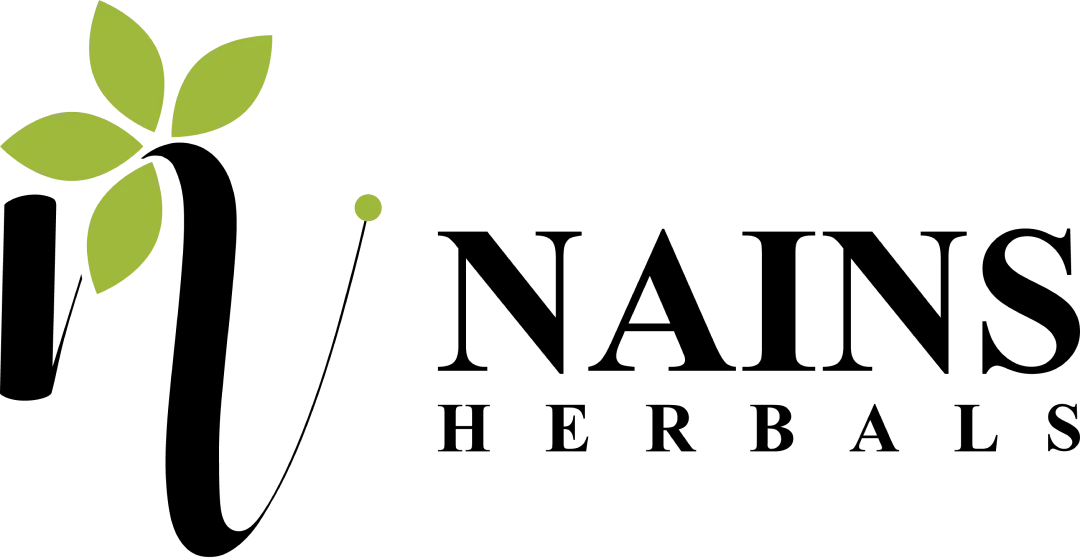5 Ways to Use Hibiscus for Healthy Hair
Introduction: Discover the Secret of Hibiscus for Naturally Healthy Hair
- Modern science is finally catching up to the centuries-old use of hibiscus as a natural treatment for hair issues in traditional Ayurvedic medicine.
- Hibiscus is more than simply a garden flower; it is well-known for its vibrant red petals and abundant nutritional value.
- Hibiscus for Healthy Hair It is a tried-and-true botanical component that, without the use of dangerous chemicals, can support hair growth, strengthen roots, and improve scalp health.
- I’ve personally experimented with and suggested hibiscus in a variety of forms, including powders, fresh petals, infused oils, and water-based gels, to clients dealing with problems like hair loss, dandruff, dryness, and breakage because I have a strong background in the field of natural hair care formulation.
- Regardless of hair type, I have witnessed firsthand how regular application of hibiscus-based therapies may drastically improve hair health through formulation instruction and practical experience.
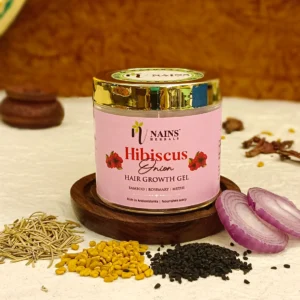
- What, therefore, makes hibiscus so potent?
- Vitamin C, amino acids, flavonoids, alpha hydroxy acids (AHAs), and antioxidants are all abundant in hibiscus.
- These nutrients boost collagen production, improve blood circulation in the scalp, unclog hair follicles, and provide deep hydration.
- The flower is perfect for persons with dandruff or scalp buildup because of its inherent acidic qualities, which also assist to regulate the pH of the scalp and gently exfoliate dead skin cells.
- In fact, hibiscus leaf and flower extracts dramatically increased hair development in animal models, according to a study published in the Journal of Ethnopharmacology.
- This confirms the centuries-old assertion made in Ayurvedic writings that hibiscus is a natural hair follicle and scalp rejuvenator.
- Hibiscus for Healthy Hair In contrast to synthetic hair products, which frequently only produce short-term effects, hibiscus targets the underlying causes of hair damage, such as oxidative stress, inflammation, and protein loss.
- The finest aspect? All hair types can use it, including curly, straight, wavy, chemically treated, and prematurely graying hair.
- We’ll look at seven really useful and efficient ways to use hibiscus for healthier, stronger, and glossier hair in this blog.
- Every technique, from homemade masks and herbal rinses to infused oils and natural gels, is simple to produce at home with either powdered or fresh hibiscus blossoms.
- You’ll also learn how to blend hibiscus with other Ayurvedic substances like fenugreek, amla, or coconut oil for additional effects.
1. Hibiscus Hair Oil
- In-Depth Nutrition for More Robust Roots
- strengthens hair follicles and increases blood flow to the scalp.
- decreases hair loss and breaks less.
- Hibiscus flowers can be used by infusing them with coconut or sesame oil.
- To get the finest effects, massage twice a week.
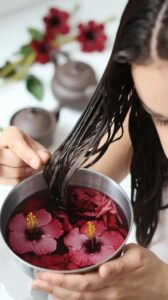
- In-Depth Nutrition for More Robust Roots:
- In the fast-paced world of today, hair loss, weak roots, and poor scalp health are frequent issues.
- Hibiscus-infused hair oil is one of the best and most tried-and-true therapies for reversing these problems in a holistic, natural method.
- When used as a foundation for scalp massage oils, hibiscus (Hibiscus rosa-sinensis), known in Ayurveda as a “keshya” herb (a hair growth promoter), nourishes the scalp, fortifies the roots, and encourages the growth of healthier, thicker hair.
- Why Pick Oil from Hibiscus?
- I’ve been creating herbal haircare formulas for over six years as a natural beauty formulator, and I’ve witnessed how hibiscus oil works better than a lot of commercial treatments when used regularly. This is the reason:
- The amino acids included in hibiscus aid in the synthesis of keratin, the protein that makes up your hair.
- It increases blood flow to the scalp, which supplies the hair follicles with nutrients and oxygen.
- Hibiscus-infused oil aids in damage healing, lessens hair breakage, and delays the onset of graying.
- Additionally, it contains anti-inflammatory and anti-fungal qualities that aid in the treatment of scalp disorders like itching and dandruff.
- Because of this, hibiscus oil is a holistic therapy that nourishes, repairs, and protects your hair organically from root to tip.
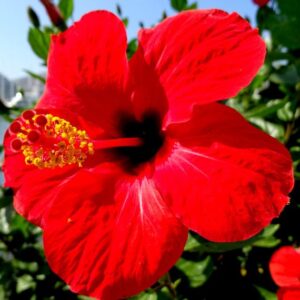
- How to Produce Hair Oil at Home with Hibiscus:
- Here is a quick and easy do-it-yourself recipe for hibiscus hair oil that calls for very few ingredients:
- Components: ½ cup of sesame or cold-pressed coconut oil
- Two tablespoons of hibiscus powder or a handful of fresh hibiscus blossoms and leaves
- Optional: For added nutrition, add 1 tsp amla powder or a few methi (fenugreek) seeds.
- Method:
- In a pan with a thick bottom, heat the oil over low heat.
- Add the leaves, petals, and optional herbs of the hibiscus.
- Simmer gently for 5 to 7 minutes, or until the petals are crisp and black.
- After cooling, filter the oil into a glass container and keep it somewhere dry and cool.
- How to Use It:
- To improve absorption, warm the oil a little before using.
- Using circular motions with your fingertips, massage it into your scalp.
- For deeper penetration, leave it on overnight or for at least one to two hours.
- Use a gentle, herbal shampoo to wash.
- Professional Advice: After using the oil, wrap a warm cloth around your head for maximum efficacy. This facilitates deeper penetration of the nutrients by opening up the pores on the scalp.
- Regularity: Use the oil two to three times a week for four to six weeks to observe stronger roots, better texture, and less hair loss.
2. Hibiscus Hair Mask
- A Natural Conditioner for Hair That Is Silky Smooth
- A hibiscus hair mask might be your go-to natural remedy if your hair seems dry, lifeless, or damaged as a result of heat styling, pollution, or chemical treatments.
- This mask functions as a deep conditioner, nourishing the scalp to promote hair development while also restoring moisture and gloss.
- Because they are high in mucilage, amino acids, flavonoids, and antioxidants, hibiscus flowers and leaves- which are widely utilized in Ayurvedic practices-are perfect for revitalizing dead hair without the use of artificial substances.
- As a professional herbal formulator who has worked with numerous botanicals that restore the scalp and hair, I have seen that hibiscus works better than store-bought conditioners in terms of softness, strength, and shine, particularly when mixed with curd or aloe vera.
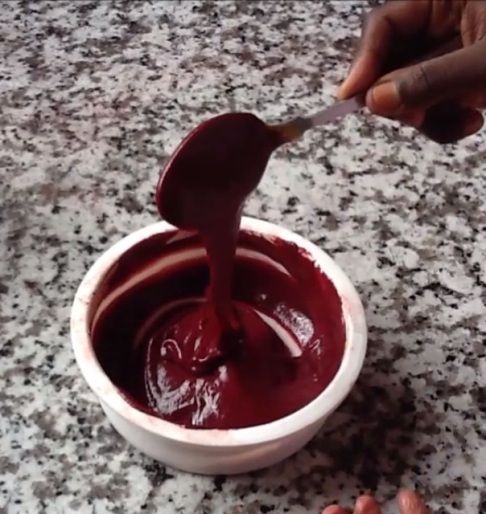
- Why Use a Hibiscus Hair Mask?
- Hibiscus’s natural mucilage softens and detangles hair.
- AHAs and flavonoids promote healthy follicles by gently exfoliating the scalp.
- Amino acids improve the thickness and structure of hair by increasing the production of keratin.
- A hydration boost from curd or aloe vera gives dry hair tremendous moisture.
- Anti-inflammatory properties calm the scalp and lessen flakiness or itching.
- Recipe for a Homemade Hibiscus Hair Mask:
- This mask is easy to create at home with basic, everyday products.
- Ingredients: two tablespoons of hibiscus powder or six to eight fresh hibiscus blossoms
- Aloe vera gel (for an oily scalp) or two tablespoons of thick curd (for dry hair)
- One teaspoon of honey is optional for added smoothness and luster.
- Method:
- To make a smooth paste, blend fresh hibiscus petals with a few spoonfuls of water.
- Combine curd or aloe vera gel with this paste until a creamy consistency is achieved.
- If you want more hydration and shine, add honey.
- For optimal effects, use right away; do not store.
- How to Apply:
- Before applying, lightly dampen your hair.
- Apply the mask to your hair in sections, working your way from roots to ends.
- To enhance absorption, concentrate on the scalp and give it a light massage.
- Put a shower cap on your hair and go for 30 to 45 minutes.
- Use a gentle herbal shampoo and lukewarm water to rinse.
- How Often to Use:
- If your hair is damaged, frizzy, or dry, use it once a week.
- Use aloe vera with curd every ten days for greasy or dandruff-prone scalps.
- Expert Formulator’s Tip: Mix 1 tsp of bhringraj or fenugreek powder into this mask for added nourishment. Both work well with hibiscus and are great for scalp health and hair development.
3. Hibiscus Hair Gel
- Combining Frizz Control with Growth Support
- Hibiscus hair gel is a game-changer if you’re searching for a natural way to control frizz, reduce flyaways, and simultaneously encourage healthy hair development.
- This gel is nutrient-rich, lightweight, and non-greasy, making it perfect for everyday usage, particularly in humid conditions where hair tends to frizz, puff, or lose definition.
- I can state with confidence that hibiscus gel bridges the gap between styling and nourishing because I have created and tested a several of natural gels, including our very own Hibiscus Onion Hair Gel.
- This botanical gel promotes root strength, luster, and scalp health while providing a natural hold, in contrast to chemical-laden hair gels that contain drying alcohol or artificial fixatives.
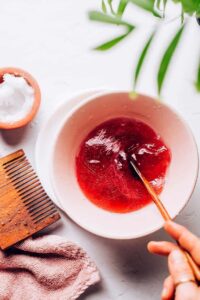
- Why Hibiscus Gel Is So Effective:
- The slick texture of mucilage-rich petals coats and nourishes hair strands.
- The hair shaft is hydrated and kept from becoming dry by natural sugars and amino acids.
- Encourages blood flow, particularly when applied to the scalp.
- Reduces dandruff and soothes irritated scalps.
- It doesn’t weigh down or stiffen hair and may be used every day.
- The Basic Version of the DIY Hibiscus Hair Gel Recipe:
- Here’s a quick and easy method to produce your own Hibiscus Onion Hair Gel if you’re not using a store-bought version:
- Ingredients: two tablespoons of hibiscus powder or six to eight hibiscus flowers
- One tablespoon of flaxseeds (for omega-3s and gel texture)
- One cup of water
- For added advantages, optional: 1 tablespoon of onion juice or aloe vera gel
- Method:
- Bring water to a slow boil with hibiscus blossoms and flaxseeds.
- Simmer for 8 to 10 minutes, or until the mixture thickens and takes on the consistency of gel.
- While the gel is still warm, strain it through a muslin towel.
- Store in a clean jar after cooling and adding the onion juice or aloe vera, if using.
- If no preservative is added, store in the refrigerator and use within 7–10 days.
- How to Apply
- As a daily style gel: Use a tiny bit on dry or damp hair to control frizz, define curls, and tame flyaways.
- As a scalp treatment: To promote growth and reduce itching, lightly apply to the scalp before bed.
- When it’s hot outside, mix with rose water and mist the roots to cool and hydrate them.
- Formulator’s Advice
- If you want to make this gel look more professional and prolong its shelf life, add 0.5% to 1% of a natural preservative such as Geogard ECT.
- Consider using essential oils of lavender or rosemary for aroma; both are excellent for stimulating the scalp.
4. Hibiscus Leaf Rinse
- Final Herbal Rinse for a Scalp Free of Dandruff
- Healthy hair starts with a healthy scalp, and if you’re having problems with dandruff, flaking, or itching, a hibiscus leaf rinse is a mild yet effective treatment that you should incorporate into your haircare regimen.
- Hibiscus leaves and blossoms provide cooling, anti-inflammatory, and anti-fungal properties that help cleanse the scalp and bring it back to equilibrium when used as a last rinse following shampooing.
- This rinse, which combines current trichology with Ayurvedic principles, is perfect for people who want to get rid of dandruff without using harsh chemical shampoos.
- As a specialist in herbal formulation, I’ve witnessed customers realize notable improvements in their scalps after only a few weeks of regular use.
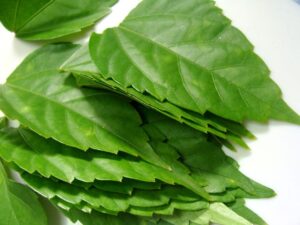
- Ingredients for this do-it-yourself hibiscus leaf rinse recipe: 10–12 fresh hibiscus leaves
- Three to four hibiscus blossoms (not required, but suggested)
- Two cups of water
- For extra dandruff-fighting effectiveness, add one teaspoon apple cider vinegar or five drops of tea tree oil.
- Method:
- To get rid of dirt, give the leaves and flowers a good wash.
- Add the hibiscus leaves and blossoms to two cups of boiling water.
- The water should turn a deep red or greenish-red after 7 to 10 minutes of simmering.
- After cooling, pour the contents into a jug or basin.
- If used, add supplementary substances like tea tree oil or ACV.
- How to Use:
- As usual, shampoo and condition your hair.
- Slowly apply the chilled hibiscus liquid to your hair and scalp as a last rinse.
- Spend two to three minutes softly massaging.
- For optimal effects, let it air dry rather than rinsing it out.
- To prevent frizz after application, use a cotton T-shirt or microfiber towel.
- Ideal Use Time: For scalps prone to dandruff, use this rinse twice a week.
- Use it once a week as a preventative measure to maintain a balanced and itchy scalp.
- Expert Formulator’s Tip: For extra antibacterial benefits, mix hibiscus leaf rinse with neem or rosemary for persistent dandruff.
- To further enhance the health of your scalp, you may also switch between this and a fenugreek water rinse.
5. Hibiscus and Amla Pack
- Strengthening Hair Power Combo
- Amla and hibiscus are one of the most potent natural hair care combinations.
- In Ayurveda, both components are highly valued for fostering healthier, stronger, and glossier hair.
- Amla (Indian gooseberry) is high in Vitamin C and antioxidants that fortify hair follicles and stop breakage, while hibiscus is well-known for its conditioning, scalp-soothing, and growth-stimulating qualities.
- When combined, they create the perfect natural remedy for hair damage, thinning, and dullness.
- I suggest this Hibiscus + Amla hair pack to people who are having problems with weak roots, excessive breakage, or loss of shine because I am a formulator that specializes in natural hair masks and Ayurvedic scalp remedies.
- In just a few applications, it produces noticeable results, is inexpensive, and is easy to make.
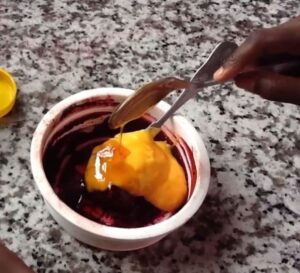
- Why Amla and Hibiscus Make the Ideal Combination
- High in mucilage, flavonoids, and amino acids, hibiscus helps condition the scalp and encourage the synthesis of keratin.
- Amla is a natural source of tannins and vitamin C, which fortify hair strands and increase the creation of collagen for quicker regeneration.
- These cooling and anti-inflammatory compounds are perfect for sensitive or irritated scalps.
- The mixture helps resurrect dormant follicles by increasing blood flow to the scalp.
- Provides deep conditioning without making the hair feel heavy.
- This combination works particularly well for people who have early greying, thinning hair, seasonal hair loss, or dull, brittle hair from chemical damage or heat styling.
- Ingredients for the DIY Hibiscus and Amla Pack Recipe
- Two tablespoons of hibiscus powder, or fresh petal paste
- Two tablespoons of amla powder
- For dry hair, use 2-3 tablespoons of curd or aloe vera gel; for an oily scalp, use herbal tea.
- Optional: 1 tsp castor or coconut oil for extra nutrition
- Procedure:
- In a bowl, combine the amla and hibiscus powders.
- To create a smooth paste, gradually add curd or aloe vera gel.
- If your hair is really dry or damaged, blend in the oil.
- To activate the botanicals, let the mixture sit for five to ten minutes.
- Use right away; don’t store.
FAQS
Q1. Can I use hibiscus on my hair daily?
Yes, you can use hibiscus-based products like hair gel or hair rinse daily, especially if they are light and natural. However, masks and oil treatments are best used 2–3 times a week.
Q2. Which is better—hibiscus powder or fresh hibiscus?
Both work well. Fresh petals offer more mucilage (slip), while powder is convenient and effective in masks and oils. Choose based on availability and your hair routine.
Q3. Does hibiscus help with hair growth?
Yes. Hibiscus stimulates blood circulation to the scalp, strengthens hair roots, and promotes growth by supporting keratin production.
Q4. Is hibiscus safe for all hair types?
Absolutely. Hibiscus is gentle and beneficial for all hair types, including curly, wavy, straight, color-treated, and chemically processed hair.
Q5. Can hibiscus treat dandruff and itchy scalp?
Yes. Hibiscus has anti-inflammatory and antifungal properties that help soothe itchiness, reduce flakes, and maintain a healthy scalp environment.
Q6. Will hibiscus darken my hair or stain it?
Hibiscus may give a slight reddish tint if used frequently, especially on light-colored or grey hair. However, it’s subtle and often seen as a natural shine enhancer.
Q7. How long should I leave hibiscus hair masks on?
Leave it on for 30–45 minutes for deep conditioning and scalp benefits. Longer is not harmful, but ensure it doesn’t dry out on the scalp.
Q8. Can I use hibiscus along with other herbs like amla or fenugreek?
Yes! Hibiscus pairs beautifully with amla, fenugreek, bhringraj, aloe vera, and more. These combinations boost its effectiveness for hair growth and nourishment.
Q9. How soon will I see results with hibiscus hair care?
You may notice improved softness and reduced frizz after the first use. Visible hair growth or reduction in hair fall typically takes 4–6 weeks of consistent use.
Q10. Can I use hibiscus on colored or chemically treated hair?
Yes. Hibiscus is gentle and restorative, making it suitable for chemically treated, bleached, or colored hair. It helps repair damage and improve elasticity.
